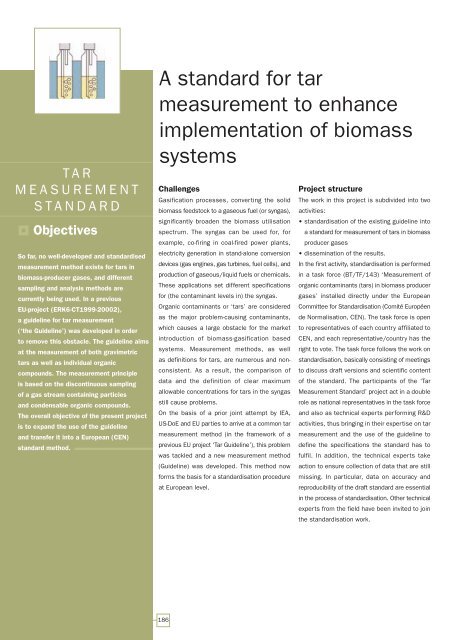European Bio-Energy Projects
European Bio-Energy Projects
European Bio-Energy Projects
Create successful ePaper yourself
Turn your PDF publications into a flip-book with our unique Google optimized e-Paper software.
TAR<br />
MEASUREMENT<br />
STANDARD<br />
Objectives<br />
So far, no well-developed and standardised<br />
measurement method exists for tars in<br />
biomass-producer gases, and different<br />
sampling and analysis methods are<br />
currently being used. In a previous<br />
EU-project (ERK6-CT1999-20002),<br />
a guideline for tar measurement<br />
(‘the Guideline’) was developed in order<br />
to remove this obstacle. The guideline aims<br />
at the measurement of both gravimetric<br />
tars as well as individual organic<br />
compounds. The measurement principle<br />
is based on the discontinuous sampling<br />
of a gas stream containing particles<br />
and condensable organic compounds.<br />
The overall objective of the present project<br />
is to expand the use of the guideline<br />
and transfer it into a <strong>European</strong> (CEN)<br />
standard method.<br />
A standard for tar<br />
measurement to enhance<br />
implementation of biomass<br />
systems<br />
Challenges<br />
Gasification processes, converting the solid<br />
biomass feedstock to a gaseous fuel (or syngas),<br />
significantly broaden the biomass utilisation<br />
spectrum. The syngas can be used for, for<br />
example, co-firing in coal-fired power plants,<br />
electricity generation in stand-alone conversion<br />
devices (gas engines, gas turbines, fuel cells), and<br />
production of gaseous/liquid fuels or chemicals.<br />
These applications set different specifications<br />
for (the contaminant levels in) the syngas.<br />
Organic contaminants or ‘tars’ are considered<br />
as the major problem-causing contaminants,<br />
which causes a large obstacle for the market<br />
introduction of biomass-gasification based<br />
systems. Measurement methods, as well<br />
as definitions for tars, are numerous and nonconsistent.<br />
As a result, the comparison of<br />
data and the definition of clear maximum<br />
allowable concentrations for tars in the syngas<br />
still cause problems.<br />
On the basis of a prior joint attempt by IEA,<br />
US-DoE and EU parties to arrive at a common tar<br />
measurement method (in the framework of a<br />
previous EU project ‘Tar Guideline’), this problem<br />
was tackled and a new measurement method<br />
(Guideline) was developed. This method now<br />
forms the basis for a standardisation procedure<br />
at <strong>European</strong> level.<br />
186<br />
Project structure<br />
The work in this project is subdivided into two<br />
activities:<br />
• standardisation of the existing guideline into<br />
a standard for measurement of tars in biomass<br />
producer gases<br />
• dissemination of the results.<br />
In the first activity, standardisation is performed<br />
in a task force (BT/TF/143) ‘Measurement of<br />
organic contaminants (tars) in biomass producer<br />
gases’ installed directly under the <strong>European</strong><br />
Committee for Standardisation (Comité Européen<br />
de Normalisation, CEN). The task force is open<br />
to representatives of each country affiliated to<br />
CEN, and each representative/country has the<br />
right to vote. The task force follows the work on<br />
standardisation, basically consisting of meetings<br />
to discuss draft versions and scientific content<br />
of the standard. The participants of the ‘Tar<br />
Measurement Standard’ project act in a double<br />
role as national representatives in the task force<br />
and also as technical experts performing R&D<br />
activities, thus bringing in their expertise on tar<br />
measurement and the use of the guideline to<br />
define the specifications the standard has to<br />
fulfil. In addition, the technical experts take<br />
action to ensure collection of data that are still<br />
missing. In particular, data on accuracy and<br />
reproducibility of the draft standard are essential<br />
in the process of standardisation. Other technical<br />
experts from the field have been invited to join<br />
the standardisation work.

















